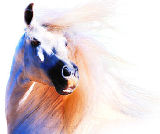|
Never attempt
to Screw through the Mirror without first drilling a hole
of the right size (2 to 3mm wider than the screw). Read
the section on Drilling Mirrors overleaf carefully before
proceeding.
Use wide headed
screws and Use plastic mirror cover caps with the screws
you fix with. These will protect the acrylic stable mirror
from damage from the screw tightening onto its surface and
the cover cap will ensure that there are no sharp edges on
the screws that your horse or pony can touch. These are fitted
over the screw before it is screwed up through the hole you
have drilled in the stable mirror. Most hardware and DIY shops
will stock them. Ensure that the screws are the right size
for the plastic cover caps and that they fit comfortably through
the holes you have drilled in your stable mirror.
When positioning
the screw though the hole in the Stable Mirror ensure
that it is central and not touching the sides of the hole,
this allows for any minor expansion or contraction of the
mirror through temperature changes.
Take Care
with the final tightening of the screws, this should be
by hand to avoid over-tightening. Over-tightening a screw
into a wood backing plate or stable lining can cause the screw
to be drawn into the wood and this may distort the stable
mirror and cause star cracking around its fixing point. This
will not happen if you avoid over-tightening the screw, if
you see any distortion of reflection around the screw - slacken
it off until this disappears.. For this reason use great care
if you are using a drill to screw the screws in, stop before
the screw is tight and finish off by hand. We can not accept
any responsibility if you do not follow this simple precaution.
Cutting Stable
Mirrors
We do not recommend that you try and cut stable mirrors and
cannot accept any responsibility for this if you do. Even
with very sharp and fine toothed saw blades there is a danger
of cracking to the sides of the cut leaving sharp or dangerous
edges
CAUTION:
Fixing to the Wall or Backing Plate
If you are fixing anything to a building wall you must ensure
that you have followed all normal safety precautions and particularly
to ensure that you are not going to drill or screw into a
power cable or water pipe ! This may seem unlikely in your
stable but it is better to be safe than sorry, if in any doubt
check first. .
Drilling
Holes in Stable Mirrors.
Work out where the holes in the stable mirror need to be drilled
before drilling and mark these with a felt tip. .We suggest
that you use one screw every 50cm - 70cm along the long side
and approximately 2.5cm in from the edge of the mirror. Try
and line this up with any uprights behind a wall lining as
above if possible and vary distances accordingly.
When you drill
into Acrylic use a sharp drill as a blunt drill can cause
cracking if it does not cut cleanly. There are special plastic
drills available but a normal twist drill can be used. If
you use one of these try and use a variable speed electric
drill and drill at a slow speed setting to avoid the acrylic
becoming hot.
Make sure your
stable mirror is adequately supported before drilling.
When
Drilling a Stable Mirror - DO
|

